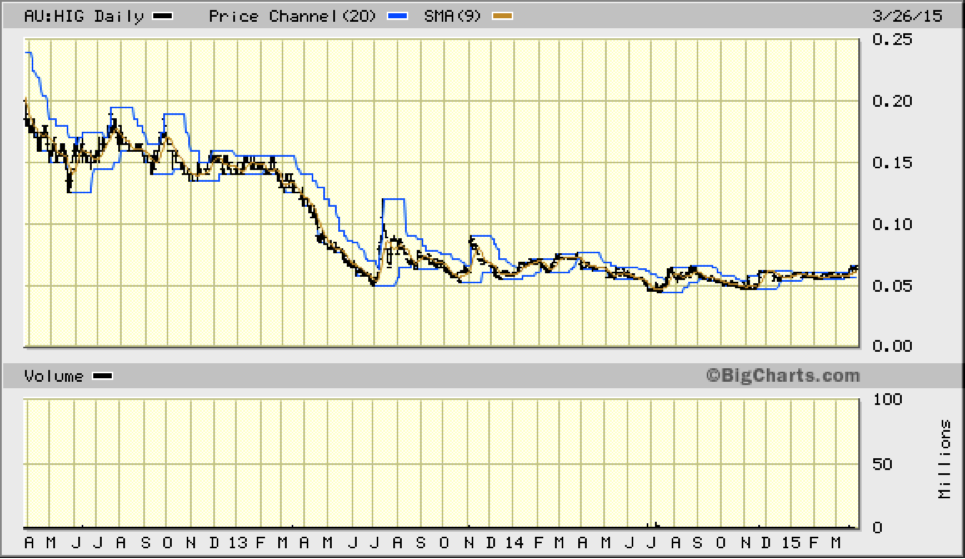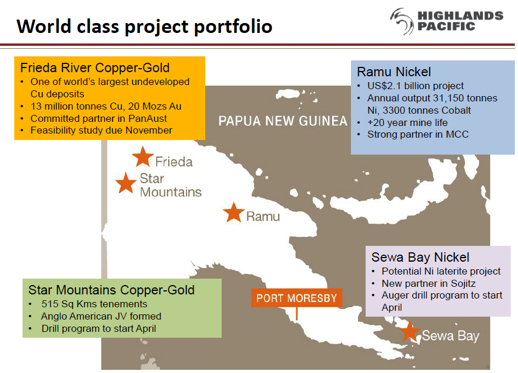Highlands Pacific (ASX: HIG, Share Price: $0.066, Market Cap: $61m) is an emerging PNG resource play, with two advanced projects and an early-stage exploration play, which we’ve followed for a number of years via our Watch-List. Various coincident factors have led us to upgrade our recommendation from Watch to Speculative Buy.
Firstly, HIG’s share price has stabilized after several years of decline, providing a confident entry point. Additionally, the Ramu nickel-cobalt project is now producing solidly, uncertainty surrounding the Frieda copper-gold project has been removed with PanAust’s buy-out of Xstrata, and corporate interest is growing with trading giant Trafigura increasing its stake to 16.03%.
The 3-year share price chart below demonstrates why we have upgraded our stance on HIG from Watch to Spec Buy, with share price performance stabilizing due to a combination of positive developments.

Market Significance
Highlands’ poor share price performance over recent years has been reflective of a very difficult market for junior companies, along with lingering uncertainty over the corporate future of one of its key projects, Frieda River. With the ownership issue resolved and confidence beginning to return, HIG’s share price has firmed by 50% over the past four months from $0.044 to a close today of $0.066.
Recent Key Developments
Trafigura Boosts Stake
Trading giant Trafigura has this week upped its stake in Highlands Pacific from 9.7% to 16.03% via the purchase of more than $4 million worth of shares, including a tranche previously held by PNG superannuation fund, Nasfund. Trafigura first acquired a stake in Highlands during November 2014, when it bought an initial 9.7% stake from Sydney resources fund Baker Steel. The intentions of Trafigura are not yet clear.
PanAust Acquisition of Xstrata’s Frieda River Stake
Following the completion of PanAust (ASX: PNA) acquisition of Xstrata’s 80% stake in the Frieda River copper-gold project during Q3 2014, PanAust has continued to advance work on the project feasibility study, which remains on schedule for completion during 2015. PanAust importantly brings a revitalized approach and revised development plan for Frieda, having also subscribed for a $10 million placement in Highlands that’s given it a 14% stake.
PanAust is responsible for all costs associated with the Frieda project joint venture right through to the Definitive Feasibility Study (DFS) stage, whilst also being responsible for 100% of the costs to maintain the Frieda project site, assets and community relations programs up to the point of lodgement of the Mining Lease or Special Mining Lease application.
As part of its due diligence work on Frieda, PanAust has completed a Scoping Study based on a smaller 24 Mtpa conventional open-pit and flotation operation, producing a copper‐gold concentrate for export to custom smelters. The beauty of this scenario is that it is significantly less costly and much more manageable in the current market environment than Xstrata’s previous design plan.
PanAust estimates total development cost in the range of US$1.5 – US$1.8 billion, which equated to a competitive capital intensity of less than US$13,000/t of annual copper equivalent production.
The Frieda River district mineral endowment totals around 2.8 billion tonnes of resource, containing 12.9 Mt of copper and 20.4 Moz of gold, making it PNG’s largest and most important copper‐gold project. The studies to date have focused only on the three deposits – Horse, Ivaal and Trukai – which are estimated to contain 2.09 billion tonnes at a grade of 0.45% copper, 0.22g/t gold and 0.70g/t silver.
Receipt of Ramu Operating Surpluses
Highlands announced during late February that it had conditionally exercised its right to begin receiving its share of the cash operating surpluses from the Ramu project, commencing 1 January 2015 with an 8.56% project interest. Under the joint venture agreement in place for the Ramu project, Highlands was entitled to nominate, at a date of its choosing, when it wished to begin participating in the operating results, effectively shielding it from losses incurred during the commissioning stage.
Highlands’ decision to participate in the operating results of Ramu came after the operator, Metallurgical Corporation of China (MCC), revealed the project had achieved its first annual operating surplus of approximately US$67 million during 2014 (unaudited). After capital expenditure of US$23 million, the net cash surplus was $44 million.
Following its decision to participate, Highlands’ will begin receiving its pro-rata share of operating surpluses, and will continue to contribute its share of on-going capital expenditure requirements. Of the funds to be distributed to Highlands, commencing during the June quarter 2015, 80% initially will be applied to repay its 8.56% share of a capped Ramu capital cost of $1.010 billion (approximately US$86 million). The remaining 20% will be available to Highlands for other purposes.
Based on a nickel price of approximately $20,000/tonne, it is anticipated that Highlands will have repaid its share of the capped project capital by 2025, at which point its share in the project will increase to 11.3% at no cost. During that time Highlands expects to receive approximately US$50 million in cash flow, after debt repayments. Highlands also holds a further option to acquire an additional 9.25% interest in the project at fair market value, increasing its interest to 20.55%.
Ramu generated a surplus whilst continuing to ramp up towards full capacity, achieving a production rate of approximately 67% of nameplate for the full-year and 72% during the December quarter. Output is forecast to reach 83% of nameplate during 2015, before rising to full capacity in 2016.
During 2014, the project produced 20,987 tonnes of nickel and 2,134 tonnes of cobalt at an average production cost of approximately US$10,800 per tonne of nickel (before cobalt credits). At full annual production of 31,150 tonnes of nickel and 3,300 tonnes of cobalt, the operation is forecast to have a production cost of approximately $10,000 per tonne of nickel (before cobalt credits).
Star Mountain Farm-Out
What was important with respect to the PanAust deal was that Highlands has retained 100% control over its Star Mountains exploration project, comprising EL 1312 located 20km north of the Ok Tedi mine. Star Mountains has been an important exploration project over recent years and 100% ownership means Highlands was able examine farm‐out/joint venture options with third parties, having already spent more than US$20 million on the lease to date.
The Star Mountains exploration tenements lie within the highly prospective New Guinean Orogenic Belt, which hosts the Grasberg, Ok Tedi, Porgera and Hidden Valley mines, as well as the Frieda deposit. The company is looking for one or more copper porphyry exploration targets containing an aggregate of a minimum of 100 – 200 million tonnes of material grading 0.5 to 1% copper. These exploration target tonnes and grade ranges are considered realistic because they are well within the typical size and grade ranges expected for porphyry copper deposits in this and other southwest Pacific island arcs.

Highlands confirmed during February that it had finalized a joint venture agreement with Anglo American, encompassing exploration and development of the Star Mountains project. The joint venture agreement comprises:
– US$10 million payment – Anglo American will pay Highlands US$10 million in two tranches of US$5 million each. The first payment of US$5 million is payable on execution of the agreements with the second payment of US$5 million to be made 12 months later.
– Phase 1 (51% interest) – Anglo can earn a 51% interest in the joint venture by spending US$25 million on exploration over four years, and declaring a 43-101/JORC-compliant Inferred Resource of 3 million tonnes of contained copper-equivalent within five years.
– Phase 2 (80% interest) – Anglo American can move to an 80% interest in the Joint Venture by completing and funding a Bankable Feasibility Study (BFS) within 15 years of the execution of the Farm‐in and Joint Venture Agreements.
– Development Free‐Carry – Anglo American will provide Highlands with up to US$150 million in project development funding as a deferred free‐carry following completion of the BFS.
Highlands will continue to manage the project; however, Anglo American will have the right to take over management of the project when it has invested US$25 million in project expenditure. The project is in the advanced stage of planning an initial drilling campaign involving four holes, for a total of 3,000 metres. Drilling is to commence in April, after completion of helicopter-magnetic surveys to assist in identifying drill targets and the completion of the JV agreements.
Summary
Highlands Pacific has been a significant sharemarket underperformer over recent years, but importantly this has begun to change. Market interest will continue to grow as a result of the PanAust farm-in at Frieda River. PanAust has proven itself to be a very successful and active developer of resource project in the Southeast Asian region, and its involvement with Frieda helps underwrite confidence in its eventual development. Just as importantly, PanAust’s involvement has removed the sharemarket overhang that revolved around the uncertainty of the timing of Xstrata’s exit from the project.
The deal has left Highlands in a cashed-up position, with $13.5 million cash in its coffers at present. Highlands has also been able to negotiate a significant farm-out deal with Anglo American on its Star Mountain project and access first operating surpluses from its Ramu project. Little wonder that Trafigura has seen fit to boost its stake significantly this week.
As we indicated in our previous coverage of Highlands Pacific, we would look to upgrade our recommendation once its share price had stabilized. We are now comfortable recommending the company as a Speculative Buy around $0.066.







